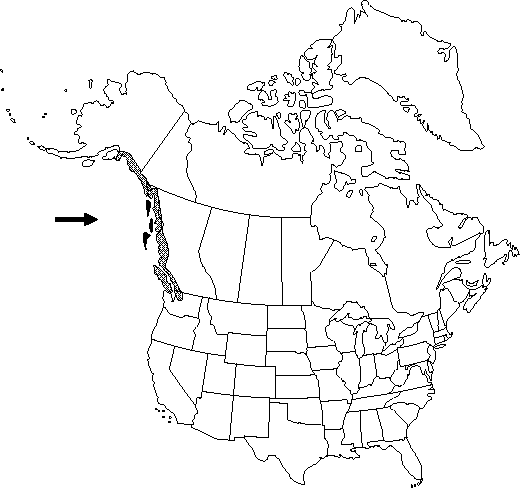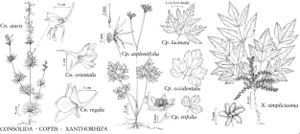Difference between revisions of "Coptis aspleniifolia"
Trans. Linn. Soc. London 8:306. 1807.
FNA>Volume Importer |
imported>Volume Importer |
||
| (7 intermediate revisions by 2 users not shown) | |||
| Line 12: | Line 12: | ||
}}{{Treatment/ID/Special_status | }}{{Treatment/ID/Special_status | ||
|code=F | |code=F | ||
| − | |label= | + | |label=Illustrated |
}} | }} | ||
|basionyms= | |basionyms= | ||
| Line 23: | Line 23: | ||
}}<!-- | }}<!-- | ||
| − | --><span class="statement" id="st- | + | --><span class="statement" id="st-undefined" data-properties=""><b>Rhizomes </b>pale brown. <b>Leaves</b>: blade 2-pinnate with pinnatifid leaflets to 3-pinnate, occasionally 2-ternate; leaflets short- to long-petiolulate, blade ovate, deeply lobed or incised, margins sharply serrate. <b>Inflorescences</b> 2-3-flowered, often longer than leaves at anthesis, 8-12 cm, elongating to 35 cm in fruit. <b>Flowers</b> nodding; sepals reflexed and ascending, linear-lanceolate, 6-11(-15)× 0.3-1 mm; petals linear-lanceolate, nectary nearly basal, blade flattened, narrowly ligulate at apex; stamens 9-15. <b>Follicles</b> 6-10; stipe equal to or slightly longer than body; body oblong, 7-10 mm; beak recurved, less than 1mm. <b>Seeds</b> 1.8-2.2 mm. <b>2n</b>=18.</span><!-- |
-->{{Treatment/Body | -->{{Treatment/Body | ||
| Line 31: | Line 31: | ||
|distribution=B.C.;Alaska;Wash. | |distribution=B.C.;Alaska;Wash. | ||
|discussion=<p>This species is widespread in coastal areas from southern British Columbia to southeastern Alaska. The Washington State Heritage Program tracks this species as "state-rare" in Snohomish County, Washington; I have not seen any specimens to confirm its presence in the state.</p><!-- | |discussion=<p>This species is widespread in coastal areas from southern British Columbia to southeastern Alaska. The Washington State Heritage Program tracks this species as "state-rare" in Snohomish County, Washington; I have not seen any specimens to confirm its presence in the state.</p><!-- | ||
| − | --><p>Coptis aspleniifolia, C. laciniata, and C. occidentalis form a group of morphologically similar, allopatric species that are probably recently derived. The species may have originated in response to the opening of the western Cordilleran landscape after Pleistocene glaciation and could be considered localized variants of a single species. Although most individuals can be readily distinguished, some can be difficult to place.</p><!-- | + | --><p><i>Coptis aspleniifolia</i>, <i>C. laciniata</i>, and <i>C. occidentalis</i> form a group of morphologically similar, allopatric species that are probably recently derived. The species may have originated in response to the opening of the western Cordilleran landscape after Pleistocene glaciation and could be considered localized variants of a single species. Although most individuals can be readily distinguished, some can be difficult to place.</p><!-- |
| − | --><p>A putative hybrid between Coptis aspleniifolia and C. trifolia has been found along the Kennedy River of Vancouver Island, British Columbia (T.C. Brayshaw, pers. comm.). It has 3-5 deeply dissected leaflets per leaf and no complete flowers.</p> | + | --><p>A putative hybrid between <i>Coptis aspleniifolia</i> and <i>C. trifolia</i> has been found along the Kennedy River of Vancouver Island, British Columbia (T.C. Brayshaw, pers. comm.). It has 3-5 deeply dissected leaflets per leaf and no complete flowers.</p> |
|tables= | |tables= | ||
|references= | |references= | ||
| Line 41: | Line 41: | ||
-->{{#Taxon: | -->{{#Taxon: | ||
name=Coptis aspleniifolia | name=Coptis aspleniifolia | ||
| − | |||
|authority=Salisbury | |authority=Salisbury | ||
|rank=species | |rank=species | ||
| Line 55: | Line 54: | ||
|publication title=Trans. Linn. Soc. London | |publication title=Trans. Linn. Soc. London | ||
|publication year=1807 | |publication year=1807 | ||
| − | |special status=Endemic; | + | |special status=Endemic;Illustrated |
| − | |source xml=https:// | + | |source xml=https://bitbucket.org/aafc-mbb/fna-data-curation/src/2e0870ddd59836b60bcf96646a41e87ea5a5943a/coarse_grained_fna_xml/V3/V3_265.xml |
|genus=Coptis | |genus=Coptis | ||
|species=Coptis aspleniifolia | |species=Coptis aspleniifolia | ||
| − | |||
| − | |||
| − | |||
| − | |||
| − | |||
| − | |||
| − | |||
| − | |||
| − | |||
| − | |||
| − | |||
| − | |||
| − | |||
| − | |||
| − | |||
| − | |||
| − | |||
| − | |||
| − | |||
| − | |||
| − | |||
| − | |||
| − | |||
| − | |||
| − | |||
| − | |||
| − | |||
| − | |||
| − | |||
| − | |||
| − | |||
}}<!-- | }}<!-- | ||
-->[[Category:Treatment]][[Category:Coptis]] | -->[[Category:Treatment]][[Category:Coptis]] | ||
Latest revision as of 21:47, 5 November 2020
Rhizomes pale brown. Leaves: blade 2-pinnate with pinnatifid leaflets to 3-pinnate, occasionally 2-ternate; leaflets short- to long-petiolulate, blade ovate, deeply lobed or incised, margins sharply serrate. Inflorescences 2-3-flowered, often longer than leaves at anthesis, 8-12 cm, elongating to 35 cm in fruit. Flowers nodding; sepals reflexed and ascending, linear-lanceolate, 6-11(-15)× 0.3-1 mm; petals linear-lanceolate, nectary nearly basal, blade flattened, narrowly ligulate at apex; stamens 9-15. Follicles 6-10; stipe equal to or slightly longer than body; body oblong, 7-10 mm; beak recurved, less than 1mm. Seeds 1.8-2.2 mm. 2n=18.
Phenology: Flowering spring.
Habitat: Moist, coniferous forests, seeps, and bogs
Elevation: 0-1500m
Distribution

B.C., Alaska, Wash.
Discussion
This species is widespread in coastal areas from southern British Columbia to southeastern Alaska. The Washington State Heritage Program tracks this species as "state-rare" in Snohomish County, Washington; I have not seen any specimens to confirm its presence in the state.
Coptis aspleniifolia, C. laciniata, and C. occidentalis form a group of morphologically similar, allopatric species that are probably recently derived. The species may have originated in response to the opening of the western Cordilleran landscape after Pleistocene glaciation and could be considered localized variants of a single species. Although most individuals can be readily distinguished, some can be difficult to place.
A putative hybrid between Coptis aspleniifolia and C. trifolia has been found along the Kennedy River of Vancouver Island, British Columbia (T.C. Brayshaw, pers. comm.). It has 3-5 deeply dissected leaflets per leaf and no complete flowers.
Selected References
None.
